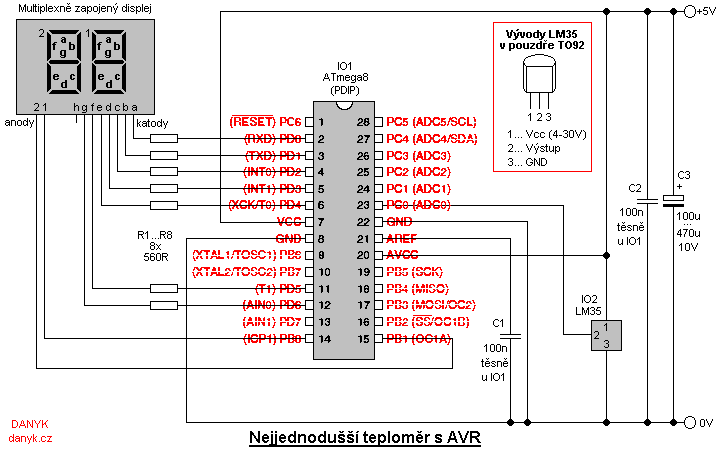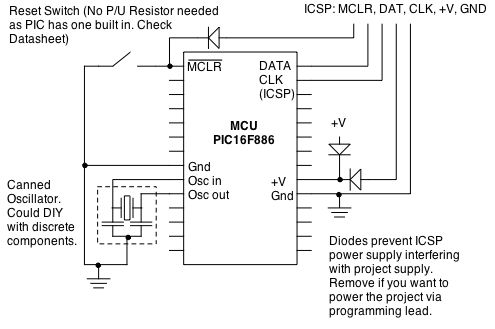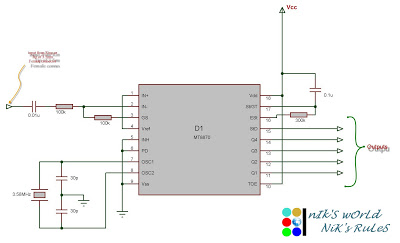
Programming the AVR Microcontroller with GCC

It is a single integrated circuit that includes EEPROM, RAM, an analog-to-digital converter, numerous digital input and output lines, timers, and a UART for RS-232 communication, among other features. A complete programming environment is available for Linux, allowing programming of this microcontroller in C using GCC. This article will explain how to install and utilize GCC, as well as how to load software into the microcontroller. Required components include an AT90S4433 microcontroller, a 4 MHz crystal, some cables, and a few other inexpensive parts. This article serves as an introduction; a subsequent article will detail the construction of an LCD display with push buttons, analog and digital inputs, a hardware watchdog, and LEDs, aimed at creating a general-purpose control panel for a Linux server. First, the focus will be on setting up the programming environment. The installation will place all programs in the /usr/local/atmel directory to keep them separate from the standard Linux C compiler. The binutils package provides essential low-level utilities for building object files, including an AVR assembler (avr-as), linker (avr-ld), library handling tools (avr-ranlib, avr-ar), programs for generating object files loadable to the microcontroller's EEPROM (avr-objcopy), disassembler (avr-objdump), and utilities like avr-strip and avr-size. A small test circuit will be constructed to verify the development environment, which will compile, download, and test a simple program to blink an LED. It is recommended to create a small printed circuit board for the microcontroller, which can later be expanded for further experiments. A breadboard is suggested for additional experimentation, although the AVR and its 4 MHz crystal should not be placed directly on the breadboard. Instead, short wires should connect the input and output lines to the breadboard, as breadboards are not designed for high-speed digital circuits. The 4 MHz crystal and capacitors should be located close to the microcontroller. Resistors on the programmer connector are only necessary if the port-B input/output lines will be used for other applications. The components required are common and inexpensive, with the microcontroller costing approximately 7.50 Euros. While it is a widely used microcontroller, it may not be available at all local electronics stores, but larger distributors in countries such as Germany and France typically stock them. Although a breadboard is not used in the initial setup, it is beneficial for further experiments. It is advisable to keep the microcontroller, crystal, and capacitors on the matrix board while connecting input/output lines to the breadboard via short cables, allowing programming without removing the microcontroller from the board. Ready-made programmer hardware is available for 50-150 Euros, but a simpler and more cost-effective solution is to use Linux with the uisp software and a free parallel port to create an efficient AVR programmer using a simple cable. The wiring for the programmer cable must follow specific configurations. The AT90S4433 can be programmed in plain C using GCC, and while knowledge of AVR assembler can be helpful, it is not mandatory. The AVR libc includes an avr-libc-reference that documents most functions. Additionally, Harald Leitner has authored a document with numerous useful examples for utilizing the AVR and GCC.
The AT90S4433 microcontroller is a versatile component suitable for various applications, particularly in embedded systems. The integration of EEPROM allows for non-volatile storage of data, while the RAM provides temporary data storage during program execution. The onboard analog-to-digital converter facilitates the reading of analog signals, making it ideal for sensor interfacing.
The digital input and output lines enable interaction with other components, allowing for the control of devices such as LEDs, motors, and switches. Timers within the microcontroller can be utilized for precise timing operations, making it suitable for applications requiring time-sensitive tasks.
The UART interface for RS-232 communication allows the microcontroller to communicate with other devices, such as computers or other microcontrollers, enabling data exchange and control commands. This feature is particularly useful in applications requiring serial communication.
The programming environment provided under Linux simplifies the development process, allowing developers to write code in C and utilize the GCC compiler for building applications. The installation of the binutils package ensures that all necessary tools for compiling and linking are readily available, facilitating the development workflow.
The testing circuit designed to blink an LED serves as an introductory project, allowing users to familiarize themselves with the programming environment and the functionality of the microcontroller. As users gain confidence, they can expand their projects to include more complex features, such as LCD displays and user input through push buttons.
In conclusion, the AT90S4433 microcontroller, combined with a robust programming environment and a variety of peripheral components, creates a powerful platform for developing embedded systems. The flexibility to use common and inexpensive parts further enhances its appeal for hobbyists and professionals alike, making it an excellent choice for a wide range of electronic projects.It`s a single integrated circuit with EEPROM, Ram, Analog to Digital converter, a lot of digital input and output lines, timers, UART for RS 232 communication and many other things. The best is however that a complete programming environment is available under Linux: Yo u can program this Microcontroller in C using GCC. In this article I will explain how to install and use GCC. I will as well explain how to load the software into the Microcontroller. All you need for this are an AT90S4433 Microcontroller, a 4Mhz crystal, some cable and a few other very cheap parts. This article shall be only an introduction. In a later article we will build a LCD display with a few push buttons, analog and digital inputs, hardware watchdog and LEDs.
The idea is that this will be a general purpose control panel for a Linux Server but first we will learn how to setup the programming environment and that is what this article is about. We will install all the programs to /usr/local/atmel. This is to keep the program separate from your normal Linux C compiler. Create this directory with the command: The binutils package provides all the low-level utilities needed for building object files.
It includes an AVR assembler (avr-as), linker (avr-ld), library handling tools (avr-ranlib, avr-ar), programs to generate object files loadable to the Microcontroller`s EEPROM (avr-objcopy), disassembler (avr-objdump) and utilities such as avr-strip and avr-size. We will start with a small test circuit. The purpose of this circuit is just to test our development environment. We can use it to compile, download and test a simple program. The program will just cause a LED to blink. I suggest to make a small printed circuit board for the Microcontroller. You can later on extent this circuit to do your own experiments. A good idea is to use a breadboard for this. You should however not try to put the AVR with it`s 4Mhz crystal directly onto the breadboard. It is better to use a few short wires to connect input and output lines with the breadboard since such breadboards are not made for fast digital circuits.
The 4Mhz crystal and the capacitors should be physically very close to the Microcontroller. The resistors on the connector for the programmer are actually not needed in our case. You need them only if you plan to use the port-B input/output lines for other purposes. You need the parts listed in the table below. All of them are very common and cheap. Only the Microcontroller is a bit more expensive, about 7. 50 Euro. Although it is a very common Microcontroller it might not be available in every local radio shop but bigger distributors for electronic components like ( (germany), (germany), (france), etc. , probably there are similar sites in your country) have them all in stock. A breadboard. We don`t use it here but it is very useful if you want to do further experiments with the AVR. I suggest you leave the Microcontroller together with the crystal and the capacitors on the matrix board and connect the input/output lines via short cables to the breadboard.
That is: you can do not need to remove the Microcontroller form the board to program it. You will see that you can buy ready made programmer hardware for 50-150 Euro. You do not need to invest that much in a programmer. With Linux, the uisp software and a free parallel port you can build a very good and simple AVR programmer. It`s a simple cable. The wiring for the programmer cable must be as follows: The AT90S4433 can be programmed in plain C with the help of gcc.
To know some AVR assembler can be useful but it is not needed. The AVR libc comes with an avr-libc-reference which documents most of the functions. Harald Leitner has written a document with a lot of useful examples on how to use the AVR and GCC ( haraleit. pdf, 286Kb, originally from ). From Atmel`s website, ( 🔗 External reference
The AT90S4433 microcontroller is a versatile component suitable for various applications, particularly in embedded systems. The integration of EEPROM allows for non-volatile storage of data, while the RAM provides temporary data storage during program execution. The onboard analog-to-digital converter facilitates the reading of analog signals, making it ideal for sensor interfacing.
The digital input and output lines enable interaction with other components, allowing for the control of devices such as LEDs, motors, and switches. Timers within the microcontroller can be utilized for precise timing operations, making it suitable for applications requiring time-sensitive tasks.
The UART interface for RS-232 communication allows the microcontroller to communicate with other devices, such as computers or other microcontrollers, enabling data exchange and control commands. This feature is particularly useful in applications requiring serial communication.
The programming environment provided under Linux simplifies the development process, allowing developers to write code in C and utilize the GCC compiler for building applications. The installation of the binutils package ensures that all necessary tools for compiling and linking are readily available, facilitating the development workflow.
The testing circuit designed to blink an LED serves as an introductory project, allowing users to familiarize themselves with the programming environment and the functionality of the microcontroller. As users gain confidence, they can expand their projects to include more complex features, such as LCD displays and user input through push buttons.
In conclusion, the AT90S4433 microcontroller, combined with a robust programming environment and a variety of peripheral components, creates a powerful platform for developing embedded systems. The flexibility to use common and inexpensive parts further enhances its appeal for hobbyists and professionals alike, making it an excellent choice for a wide range of electronic projects.It`s a single integrated circuit with EEPROM, Ram, Analog to Digital converter, a lot of digital input and output lines, timers, UART for RS 232 communication and many other things. The best is however that a complete programming environment is available under Linux: Yo u can program this Microcontroller in C using GCC. In this article I will explain how to install and use GCC. I will as well explain how to load the software into the Microcontroller. All you need for this are an AT90S4433 Microcontroller, a 4Mhz crystal, some cable and a few other very cheap parts. This article shall be only an introduction. In a later article we will build a LCD display with a few push buttons, analog and digital inputs, hardware watchdog and LEDs.
The idea is that this will be a general purpose control panel for a Linux Server but first we will learn how to setup the programming environment and that is what this article is about. We will install all the programs to /usr/local/atmel. This is to keep the program separate from your normal Linux C compiler. Create this directory with the command: The binutils package provides all the low-level utilities needed for building object files.
It includes an AVR assembler (avr-as), linker (avr-ld), library handling tools (avr-ranlib, avr-ar), programs to generate object files loadable to the Microcontroller`s EEPROM (avr-objcopy), disassembler (avr-objdump) and utilities such as avr-strip and avr-size. We will start with a small test circuit. The purpose of this circuit is just to test our development environment. We can use it to compile, download and test a simple program. The program will just cause a LED to blink. I suggest to make a small printed circuit board for the Microcontroller. You can later on extent this circuit to do your own experiments. A good idea is to use a breadboard for this. You should however not try to put the AVR with it`s 4Mhz crystal directly onto the breadboard. It is better to use a few short wires to connect input and output lines with the breadboard since such breadboards are not made for fast digital circuits.
The 4Mhz crystal and the capacitors should be physically very close to the Microcontroller. The resistors on the connector for the programmer are actually not needed in our case. You need them only if you plan to use the port-B input/output lines for other purposes. You need the parts listed in the table below. All of them are very common and cheap. Only the Microcontroller is a bit more expensive, about 7. 50 Euro. Although it is a very common Microcontroller it might not be available in every local radio shop but bigger distributors for electronic components like ( (germany), (germany), (france), etc. , probably there are similar sites in your country) have them all in stock. A breadboard. We don`t use it here but it is very useful if you want to do further experiments with the AVR. I suggest you leave the Microcontroller together with the crystal and the capacitors on the matrix board and connect the input/output lines via short cables to the breadboard.
That is: you can do not need to remove the Microcontroller form the board to program it. You will see that you can buy ready made programmer hardware for 50-150 Euro. You do not need to invest that much in a programmer. With Linux, the uisp software and a free parallel port you can build a very good and simple AVR programmer. It`s a simple cable. The wiring for the programmer cable must be as follows: The AT90S4433 can be programmed in plain C with the help of gcc.
To know some AVR assembler can be useful but it is not needed. The AVR libc comes with an avr-libc-reference which documents most of the functions. Harald Leitner has written a document with a lot of useful examples on how to use the AVR and GCC ( haraleit. pdf, 286Kb, originally from ). From Atmel`s website, ( 🔗 External reference





